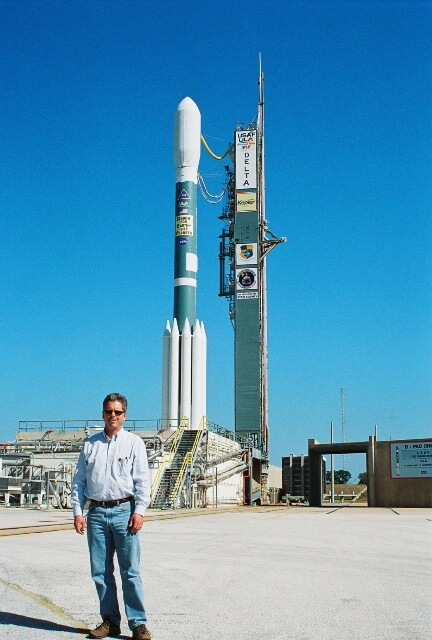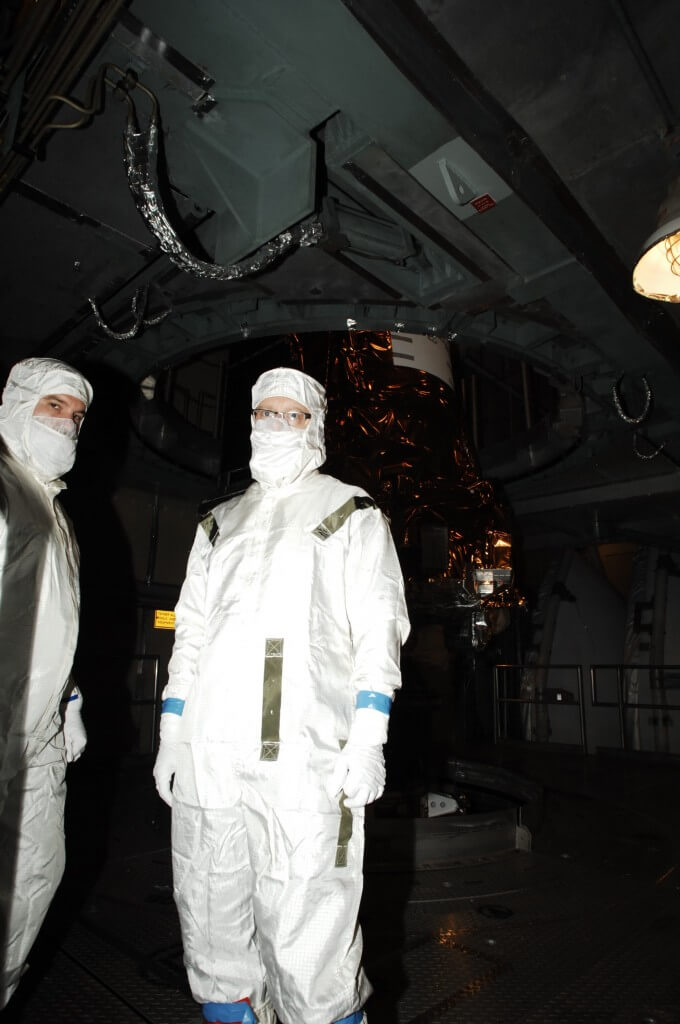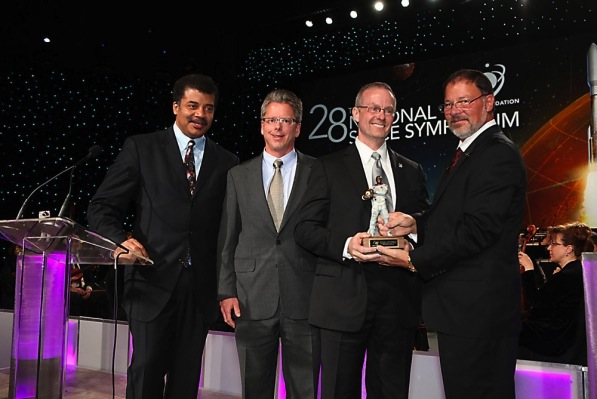Meet the Team: John Troelzsch
November 7, 2014
Biography of John Troelzsch, Sentinel Program Manager:
As the Sentinel Program Manager, John leads the team of experts at Ball Aerospace that will create and operate the Sentinel Mission. His program management, systems engineering and software experience spans all phases of space missions from the development of innovative mission concepts through launch and on-orbit operations of spacecraft in deep space. John began work on the Hubble Space Telescope in 1985, five years before it was launched. Over the next 13 years he worked as a systems engineer to build, test, launch, and operate the Goddard High Resolution Spectrograph, the COSTAR, and the Near Infrared Camera and Multi-Object Spectrometer instruments for Hubble.
John led the avionics team for the IRS and MIPS cryogenic instruments on the Spitzer Space Telescope, eventually becoming the Program Manager for IRS and a member of the Spitzer Management Team. He received NASA’s Public Service Medal for his technical and leadership contributions to Spitzer.
John currently manages the Kepler mission at Ball which has discovered over 1000 exoplanets in our galaxy. His leadership contributions on Kepler from the design phase through mission operations resulted in his award of a NASA Exceptional Public Service Medal.
John is an avid long distance runner, and lives with his wife and two daughters in Boulder, Colorado.
The Interview:
What do you find most exciting about the Sentinel Mission?
In the current phase, the thing I’m most excited about is the unique structure of the mission. No one’s ever done a grassroots mission like this before and it’s a chance to test boundaries and figure out how to do things with a fresh perspective. And that’s very different from how current government aerospace projects are run.
I also really enjoy working with people on the team who aren’t rocket scientists (laughs). It’s a really fun and excited group. I get insights into things that I wouldn’t normally see on a conventional program. It’s really a fresh approach to doing a space mission after 30 years in the business.
One thing that fascinates me is that this machine we’re going to build can see an 80-meter rock in space from 50 million miles away. Sometimes I sit in my office and think about how far we’ve come, what humanity has been able to accomplish over the last few hundred years.
It’s so fun to work on Sentinel because when I talk to people about it, they’re always fascinated. They’re eager to engage and offer their thoughts and opinions. People here at Ball, the people I met at the Aspen Science Fair, someone on a plane. It’s a universal subject. I can strike up a conversation with anyone and this mission resonates with them. They get it.
A lot of scientific endeavors are so focused on one abstract piece of information that the significance gets lost. But finding asteroids is something everyone gets. It’s almost a core reaction. Of course we should do this.
How did you become involved with the Sentinel Mission Leadership Team?
Back in March of 2011, Ed [Lu] came to Ball to ask about some work we had done on a space telescope that could find asteroids. I was brought into the discussion because I had worked extensively on Kepler and Spitzer, so it was a good fit with what I’ve done in the past.
Also, this mission is a little bit out of the box from a typical Ball government job. It needed someone to help organize and solidify and focus the effort, which is something that I do well. I know how to figure out what we know and what we don’t know, and how to fill in the blanks and craft a program around an idea.
The Sentinel Mission really fits with the work I had done and I was excited to start on it. Since then I’ve really gotten to know everyone on the Sentinel Leadership team and I have come to realize what a remarkable group we have. I feel lucky to be a part of this. The passion of the team is very contagious and the sum of our unique skills makes us strong.
How will the Sentinel Space Telescope perform over the life of the mission?
There are two parts to this answer:
The first part is that we’re going to systematically find a whole bunch of objects. I’m 100% confident that our spacecraft will do that job well, that it’s going to be a routine—almost a mundane process—just looking for these asteroids and cataloging them. We predict there are nearly a million asteroids in the inner solar system, so we will be very busy.
The second part is that there are going to be things that will surprise us. It’s the things we don’t expect that make missions interesting. For instance, with Kepler, we really had no idea we’d find as many planets as we have, or that they would be so diverse.
We’ll find what we were looking for and answer questions we haven’t even fathomed. The exploration is the fun, dynamic part of the mission. As we said on Hubble, Expect the Unexpected.
What would you like people to understand about the Sentinel Mission?
We live in a world where we take a lot of things for granted: we have GPS on our phones so we don’t have to worry about getting lost; we have a great medical establishment to help us when we have a health issue. But when I realized that most people don’t know about the number of unidentified asteroids visiting the inner solar system, it became clear we are all taking something very important, and dangerous, for granted. Namely, the risk of a mid-sized asteroid impact in a populated area.
Think about what we were taught in grade school. All the diagrams showed the planets with big black spaces in between them! The solar system is a whole lot messier than we realize, but we know how to find out what is out there and how to do it systematically. With Sentinel, we can change how people look at the solar system—that it’s not just about the big planets, but about lots of smaller objects as well.
How did you end up in the aerospace industry?
The way I ended up here was almost by accident, or maybe destiny.
I was always good at math and science but not fascinated by space. I mean, when I was young I watched the moon landings, but it didn’t spark anything in me like it did with other people who wanted to be astronauts when they grew up. I came to the industry later on, through engineering in college. I became fascinated by orbital mechanics, how bodies move through space, how satellites work, how rockets work. How things move in the vicinity of the earth and farther away in the solar system.
Since I’ve been in aerospace, I’ve really enjoyed the constant opportunity to keep learning. I’ve always loved the chance to learn something new. It’s not like you master any one thing: orbital mechanics, thermal properties… there’s always more complexity. The chance for growth has never gotten stale. Recently, I have been pondering the use of synthetic data, mock data, to probe and improve large data-processing systems. This has really helped on Kepler and I think there are some areas on Sentinel that would benefit too.
What is one of the most memorable moments in your career?
The one that comes to mind first is when we were preparing the Near Infrared Camera and Multi-Object Spectrometer (NICMOS) for its launch to be installed on Hubble. It was sitting it its special carrier in the Shuttle bay on the launchpad and we were cooling the cryo system down one last time. It was a Saturday night and the pad was totally deserted except for half a dozen folks. When we finished we took the stairs all the way down. The elevator would have been faster but it was much more fun to look at the Shuttle from top to bottom. It was just a magical experience. I’ll never forget the shuttle all lit up at night and just how complex and huge the whole system was.
Another memorable time was just before the Spitzer launch, and I was literally working on top of a half-fueled rocket 14 stories above the ground. In just 10 hours that beast was going to take off. Here I was on the job, talking on the radio with the crew like normal, but then catching myself thinking: “This is not your average day at work.”
And another memory is when I was working on Hubble at the Space Telescope Science Institute at Johns Hopkins University. It was 3am in the Science Control Room and a picture flashed up on the screen of something that happened nine billion years ago. Something no human would have seen or maybe was supposed to see and here we were, peeking into the far reaches of the universe. Hubble had captured the light with its mirror after a journey of billions of years and there we were enjoying the view.
Who are your inspirations?
In college, it was Dr. Chow, my fluid dynamics professor. He was so enthusiastic about what he taught. The material was very hard but he loved it and he was able to get us to understand it. There was a lot of passion there.
Here at Ball, it’s Wally Meyer. Wally was the Director/father of all of Ball’s Hubble instrument programs. He grew up farming in Kansas: super down-to-earth, innovative and creative. Always making do with what was available. And he was a fantastic businessman.
Once he disappeared into a conference room for about two weeks with a bunch of popsicle sticks and paper plates. I think some of us thought he’d gone off his rocker. But during those weeks, he created this model for the James Webb Telescope and it wasn’t even a NASA program yet! He knew he needed a way to fold up the telescope to make it fit on a rocket and he was determined to figure out how. The model ended up in the trash can but someone fished it out and rescued it. He figured out what the James Webb was going to look like, and folded it up into a coffee can. That was just pure Wally, figuring out how to make the next best great space telescope.
What do you like to do when you’re not building amazing spacecraft?
Well, I like to cook, and I’m a beekeeper. I planted grapes in our yard and I want to tinker with making wine. It won’t be good wine but I want to figure out the process and get some insight: how did humanity figure out how to take some fruit and make such a delicious beverage out of it?
I’m also an endurance runner and I love to ski with my family, so that’s how I get outside.
What’s on your bucket list?
The first thing that that pops is that I really have to go back to the bottom of the Grand Canyon. I’ve been there twice before but it is one of the most magical places on the planet. It’s so incredible, so stunningly beautiful and isolated and just an amazing place.
Also, I’d love to see Greenland. Seeing it out the window of an airplane from above it looks like a setting for a movie like Jurassic Park. Wild and exotic. But I’d love to see it from the ground. See the glaciers and fjords. Just not in winter. Maybe late summer.
Last question: Star Wars or Star Trek?
Star Trek, definitely. That show has always fascinated me. In fact, I just finished watching all of the episodes with my kids (except the original series). Now we’re Doctor Who’ing it.
***



















